Bourg d’Oisans, July 26th, 2011
Late afternoon and the Alps are hot. We take one last sip from our water bottles, run a quick check over each tyre pressure, then clip into the pedals. A group of tourists are watching from a small pavement cafe: the non-riders.
“Bonne chance,” one of them says, knowing exactly what we face up the road ahead. Only one of us smiles back.
There are several severe and immediate side-effects to riding a bike up Alpe d’Huez, and a vicious thirst is first among them. It’s what happens when you start forcing mind, body and spirit up the 21 severe switchbacks, each numbered in descending order, on a road that rises from 800m to 1,860m in a mere 13.8km.
From the start at Bourg d’Oisans to the old ski station at the summit, and the already dizzy altitude, there’s an average uphill gradient of 7.9 per cent, 13 per cent in parts. It straightaway feels steep, very steep. It’s also at its steepest near the bottom, which puts even the best riders in the world on their limit early on, with another particularly steep 3km in the middle, following Huez village, where the view opens up to reveal the still demoralising long way ahead.
It’s why our small peloton very quickly splits apart like loose beads on a string, each of us riding at our own pace, counting the switchbacks, losing count, looking for any hope or encouragement among the names painted on the hot road in bright colours: Schleck . . . Rollane . . . Voeckler . . . Contador!
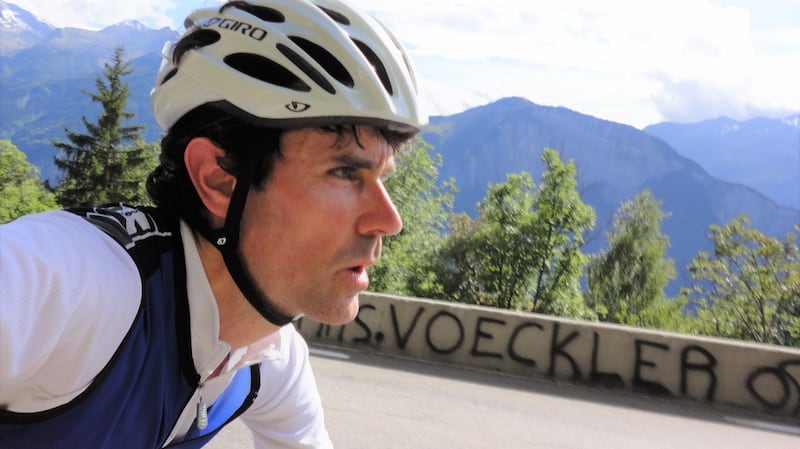
Not for us, obviously; they were here four days previously, riding up Alpe d'Huez to finish Stage 19 of the 2011 Tour de France, which in keeping with its place in race tradition rips through the general classification. More than half the peloton end up finishing outside the cut-off time for elimination, and rely on a reprieve from the race commissionaires to stay involved.
We’re here not to race up it, but to survive it, during our five-day Mini Tour de Alps, also known as the Irish Hospice Cycling Challenge, a fund-raising event covering the 523km all-hilly route from Geneva to Nice. Alpe d’Huez comes two days in, and just because you’re here for a charity doesn’t make it any easier.
Part of what sets this climb apart in the Tour is that it typically comes after several other long, hard Alpine climbs – usually on the same day. We also arrive at the Bourg d’Oisans, the gateway village, shortly after we’ve scaled the Col Du Glandon, which already hits us uninitiated where it most hurts: in the legs.
By the time we reach the ramped road towards the first switchback, we’ve been in the saddle six hours already, the legs three-quarters empty. There is no turning back: it’s why pro cyclists call it the 21 steps to hell, and see nothing whatsoever of the road as they ride up it, although that hardly does its natural evilness any justice.
Truth is Alpe d’Huez is not the longest or steepest climb in the Alps, but its iconic status in cycling folklore – particularly the Tour de France – is unrivalled. Because within the Tour, in July, it becomes not just one theatre of sport, but 21 separate amphitheatres, each one crowded beyond capacity, presenting only a rough and rowdy way through.
There are many images from in and around here which come to mind: Bernard Hinault and Greg LeMond reaching the finish in the 1986 Tour, riding over the line together, LeMond presenting Hinault with the narrow win, knowing he had won the Tour; Marco Pantani winning in 1995, the angel with the devil tattooed on his shoulder, dropping Miguel Induráin for fun, wondering what the little Italian must be on; Lance Armstrong taking the individual time-trial up Alpe d'Huez in 2004 and remembering to listen to the non-believers.
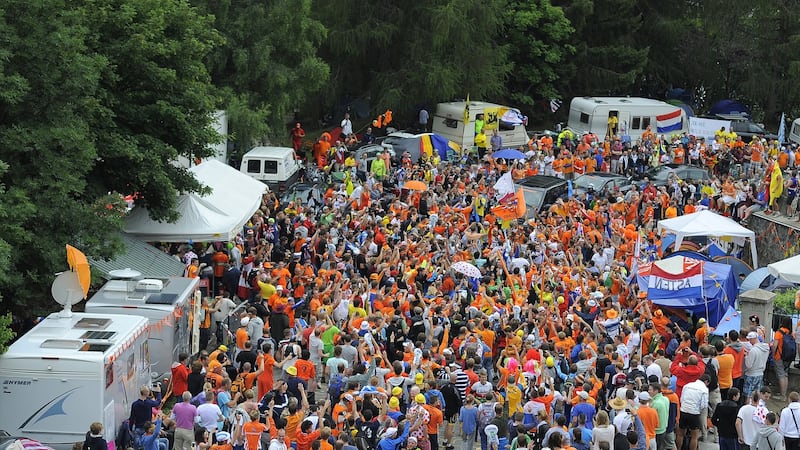
When a Tour or stage victory is on the line, Alpe d'Huez is properly chaotic and dangerous. For that 2004 time-trial, there were an estimated 500,000 spectators on the mountain, an exact number impossible to know, given they arrive by means possible, and for free. At times more music festival than cycling race, Giuseppe Guerini was knocked off his bike, just under 3km before the 1999 finish, after a spectator stepped in his way to take a photograph. The Italian recovered only by the strength of his own will, and still won that stage by 21 seconds.
The 2003 centenary Tour got particularly wild on Alpe d'Huez, for natural reasons, and in the long clean-up that followed, down in a ravine among the broken glass and empty beer cans, a body was found; a spectator had fallen off the mountain and no one even noticed. Mont Ventoux, where British rider Tom Simpson collapsed and died off his bike during the 1967 Tour, may occasionally share such cycling madness, but no mountain has provided more of it than Alpe d'Huez.
It’s a lot quieter for us, though like the marathon, it’s not the distance which kills; it’s the pace, no matter how fast or how slow. One of the secrets to not stopping is not stopping at all. It’s just before six o’clock when I make it to the top, or about 55 minutes after leaving the bottom. Climbing is not only in a slow rhythm, but a long trance – and it’s hard to snap out of it.
Time for a quick picture, then the only really pleasurable part: the ride down takes about 10 minutes, both hands gently touching the brake levers, with an unforgettable memory of touching the void, still the most brutally exhausting thing I’ve ever done on two aluminium wheels.
Indeed herein lies part of its appeal, that pure amateurs, of all abilities, get to knock and enter at the same house of sporting pain.
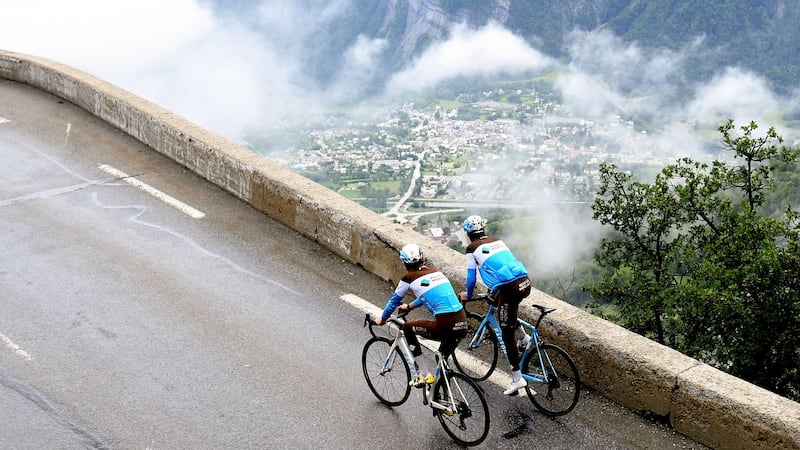
Alpe d’Huez, July 4th, 1952
"Assassins," shouted Gustave Garrigou, after the Tour de France first passed through the Alps, in 1911. Garrigou may have won the race, but realised he'd nearly killed himself in the process. And the Tour organisers realised they were on to a good thing.
In the years that followed, Jacques Goddet, the Tour director from 1936 to 1986, frequently sought out new mountains to enhance his race, and one unexpected summer another happened to fall into his lap. It was Georges Rajon who first reckoned it might be a good idea to have people cycle up Alpe d'Huez. It was 1952, and he was looking to inject some summer business into his new hotel, the Christina, named after his daughter, which he'd just built on the then unheralded mountain.
An obsessive cycling fan, Rajon asked then race commissioner Élie Wermelinger to consider a stage finish at the top, next to his hotel. It was a radical proposition: even though Tour stages had been passing through the Alps since 1911, none had actually finished on a mountain summit.
Whatever about his powers of persuasion, Rajon essentially bribed the Tour organisers, that a finish on Alpe d’Huez might attract a few extra spectators. With Goddet’s approval, it was marked for Stage 10, on July 4th, and presented many firsts. A first mountain-top finish, it was also the first stage where a TV crew followed the leader on a race motorcycle, the images of which immediately sent the mountain straight into cycling hearts.
Because first up that first Alpe d'Huez finish, in 1952, was Fausto Coppi, the slick Italian already known as Campionissimo. "Unyielding and untouchable," said L'Equipe, and indeed Coppi finished one minute and 20 seconds ahead of the next rider, adding not only to his own legendary status, but helping create the legend that became the Tour's own new Fenway Park, its Wimbledon, to sit alongside but also separate from the Galibier, the Tourmalet, and Mont Ventoux.
Coppi also went on to win the overall 1952 race, but there were logistical problems on Alpe d’Huez, not least the lack of accommodation on the mountain top, but also the feeling among some teams that the climb was simply too brutal to be fair. Although included again as a mid-stage climb in 1964, it didn’t become a regular mountain-top finish until after it was brought back there in 1976.
By then, inspired by a cycling trip up Mount Vrsic in Slovenia, Rajon got the idea of numbering each of the 21 switchbacks, now also named after each of the overall race winners, some named twice. After Joop Zoetemelk took that 1976 stage win, the first of eight Dutch riders to win the first 14 finishes at Alpe d'Huez, the place also became better known as the Dutch Mountain, although not for long.
In the now 30 stage finishes on Alpe d'Huez, there have been winners from 11 different countries, although only three other riders have matched Coppi's feat of winning on Alpe d'Huez and then wearing the maillot jaune at the finish on the Champs-Elysees: Lance Armstrong managed it twice, in 2001 and 2004, before being stripped of all seven of his Tour wins in 2012 for doping; Carlos Sastre from Spain managed it in 2008, as did Britain's Geraint Thomas, who was already wearing the yellow jersey when he won the Alpe d'Huez two years ago, going on to win the Tour. It still has a special place in the hearts of French cycling too.
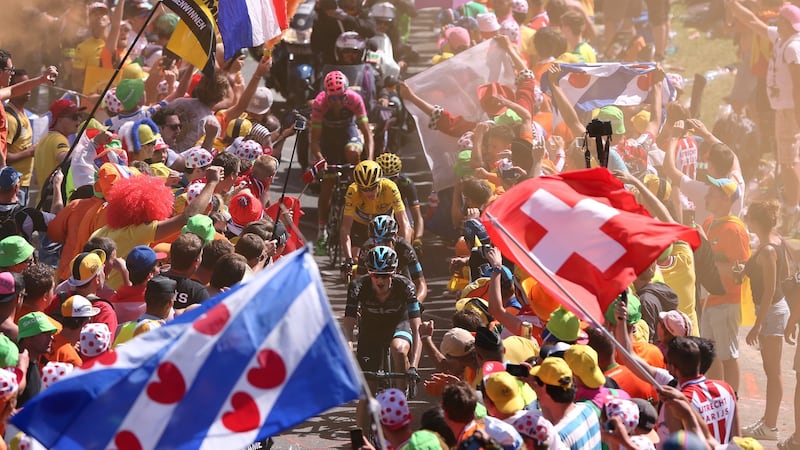
Champs-Élysées, July 24th, 1983
"The Tour may not always be won on Alpe d'Huez, but it is very often lost": so says Jean-Paul Vespini, the veteran French cycling journalist, in his 2008 book The Tour is Won on the Alpe, a proper insight into all the Tour finishes on the mountain up to that point. Indeed his book could just as easily have been titled The Tour is Lost on the Alpe. Just ask Eddy Merckx, Jan Ullrich, and even Stephen Roche. It some cases it's been won and lost on the Alpe by the same rider.
Laurent Fignon’s autobiography We Were Young and Carefree (originally published in French, in 2009, as Nous Etions Juenes et Insouciants) also recounts this. It’s sad, and poignant – not just because Fignon is best remembered as the man who lost the closest Tour finish (in 1989, by eight seconds) as opposed to the man who won it twice in 1983, and 1984, but also because he died of cancer in 2010 aged 50.
In each of those years Fignon also took over the race lead on Alpe d'Huez. He was just 22 when he rode his first Tour in 1983 – and remains one of the rare few to win it at the first attempt (the others being Coppi, Merckx, and Hinault). With that he won great admiration among the French public, who knew the considerable demands of the Tour for a youngster of 22. He was the then youngest winner since Romain Maes of Belgium won in 1935, aged just 21. "My legs and my mind were functioning in complete harmony," Fignon writes of that debut Tour victory. "That may sound pretentious but that's how it was."
In that same 1983 Tour, considered the most open in years, Roche was in contention until the race reached Alpe d'Huez: "When I hit the bottom, I went into a state of nothingness," Roche recalls in Born to Ride. "There was no light, just a complete black out. I got from the bottom to the top, but I've no idea how I did it. In the end, [Seán] Kelly finished 10 minutes ahead of me. I'd lost more than 15 minutes on the climb. My early mentor, Peter Crinnion, had come over to watch a few stages and he later told me that he'd run beside me on Alpe d'Huez shouting encouragement, but I never saw him or heard anything."
The Italians, perhaps the most obsessive stage mountain cycling nation of all, have two words to describe their best climbers; the “scalatore” are those who float up the mountain; and the “arrampicatore” are those who fly up it. Pantani was one of their purest “arrampicatore” and still holds the three fastest times ever clocked on the 13.8km ascent: 36 minutes and 50 seconds in 1995, 36:55 in 1997, 37:15 in 1994.
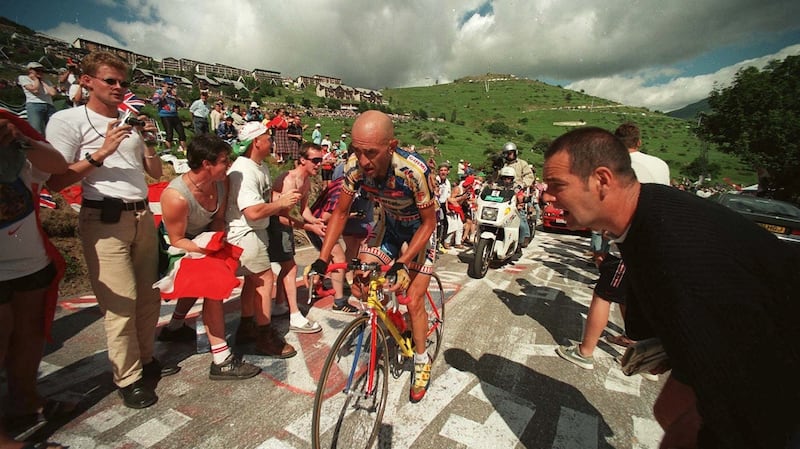
“I climbed it without ever seeing the road,” said Pantani, after his 1995 stage win. “The crowd just guided me. All I could see in front of me were the fans, who yelled out my name. I ascended like a blind man, in the middle of a sea, that opened up for me.”
What exactly Pantani was on we will never know: having become hopelessly addicted to performance-enhancing drugs, and six years after his Giro-Tour double in 1998, victory, he was found dead in a hotel room in Rimini, having consumed €20,000 worth of cocaine in the last two weeks of his life.
The next best time up the mountain is the 37:36 that Armstrong clocked in the 2004 time-trial in 2004, and we more or less know exactly what he was on. You do the math. Of the top-10 fastest times up the 13.8km stretch, only one rider, Indurain, isn’t implicated in doping.
In some twisted way that all adds to the lure of this mountain. For the 2020 Tour, postponed until the end of August, the race organisers have favoured some lesser known climbs, including the Col de la Loze in the heart of the Alps, as the standout mountain finishes. Part of the myth of Alpe d’Huez is that it’s not repeated every year, giving it, and all that ride it, some time to breathe again.













